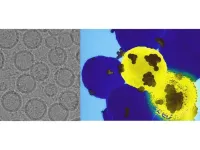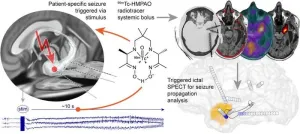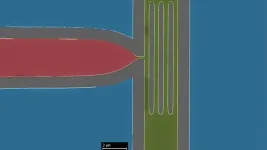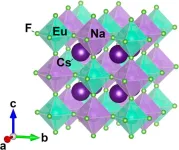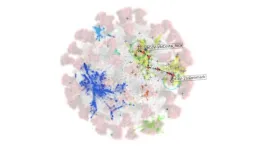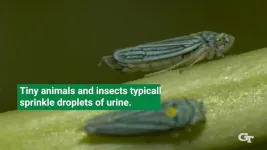(Press-News.org) UNIVERSITY PARK, Pa. — A newly developed “GPS nanoparticle” injected intravenously can home in on cancer cells to deliver a genetic punch to the protein implicated in tumor growth and spread, according to researchers from Penn State. They tested their approach in human cell lines and in mice to effectively knock down a cancer-causing gene, reporting that the technique may potentially offer a more precise and effective treatment for notoriously hard-to-treat basal-like breast cancers.
They published their work today (March 11) in ACS Nano. They also filed a provisional application to patent the technology described in this study.
“We developed a GPS nanoparticle that can find the site where it is needed,” said corresponding author Dipanjan Pan, the Dorothy Foehr Huck & J. Lloyd Huck Chair Professor in Nanomedicine and professor of nuclear engineering and of materials science and engineering at Penn State. “Once there — and only there — it can deliver gene editing proteins to prevent the cancer cells from spreading. It was a difficult task, but we showed that the system works for basal-like breast cancers.”
Similar to triple-negative breast cancers, basal-like breast cancers may be less prevalent than other breast cancers, but they can be far more challenging to treat, largely because they lack the three therapeutic targets found in other breast cancers. They also tend to be aggressive, quickly growing tumors and shedding cells that spread elsewhere in the body. Those cells can seed additional tumors, a process called metastasis.
“Metastasis is a huge challenge, especially with cancers like triple-negative and basal-like breast cancers,” Pan said. “The cancer can be hard to detect and does not show up during a routine mammogram, and it primarily affects the younger or African American population who may not be receiving preventative care yet. The outcome can be very, very poor, so there’s a clear unmet clinical need for more effective treatments when the cancer isn’t caught early enough.”
The team fabricated a Trojan horse nanoparticle, disguising it with specially designed fatty molecules that look like naturally occurring lipids and packing it full of CRISPR-Cas9 molecules. These molecules can target the genetic material of a cell, identify a particular gene and knock it down, or render it ineffective. In this case, the system targeted human forkhead box c1 (FOXC1), which is involved in instigating metastasis.
Pan described the designer lipids as “zwitterionic,” meaning they have near neutral charge on the nanoparticle’s shell. This prevents the body’s immune system from attacking the nanoparticle — because it is disguised as a non-threatening, normal molecule — and can help release the payload, but only when the lipids recognize the low pH environment of the cancer cell. To ensure the lipids would only activate at that low pH, the researchers designed them to shift their charges to positive once they enter the more acidic tumor microenvironment, triggering the payload release.
But the body is a vast place, so how could the researchers ensure the CRISPR-Cas9 payload made it to the correct target? To ensure that the nanoparticle would bind to the right cells, they attached an epithelial cell adhesion molecule (EpCAM), which is known to attach to basal-like breast cancer cells.
“No one has ever attempted to target a basal-like breast like cancer cell with context-responsive delivery system that can genetically knockdown the gene of interest,” Pan said. “We’re the first to show that it can be done.”
Others have developed viral delivery systems, hijacking a virus particle to carry treatment to the cells, and non-viral delivery systems, using nanoparticles. The difference, Pan said, for his team’s approach is the surface lipid designed to respond only in the target environment, which reduces the potential for off-target delivery and harm to healthy cells. Also, he added, since the body doesn’t consider the lipids to be a threat, there’s less chance for an immune response, which they validated in their experiments.
The team first tested the approach in human triple-negative breast cancer cells, validating that the nanoparticle would deploy the CRISPR/Cas9 system in the correct environment. They confirmed that the nanoparticle could find its way to a tumor in a mouse model, deploy the system and successfully knock down FOXC1.
Next, Pan said, the researchers plan to continue testing the nanoparticle platform with the eventual goal of applying it clinically in humans.
“We are also exploring how else we might apply the platform technology,” Pan said. “We can customize the molecules on the surface, the payload it carries, and use it to encourage healing in other areas. There’s a lot of potential with this platform.”
First author Parikshit Moitra, was a research assistant professor of nuclear engineering in Pan’s laboratory at Penn State at the time of the study and is now an assistant professor at the Indian Institute of Science Education and Research at Berhampur; David Skrodzki, Matthew Molinaro, Nivetha Gunaseelan, all doctoral students at Penn State; Dinabandhu Sar, University of Illinois, Urbana-Champaign; Teresa Aditya, postdoctoral researcher in nuclear engineering at Penn State; Dipendra Dahal and Priyanka Ray, both postdoctoral researchers in Pan’s laboratory at his previous institution of the University of Maryland Baltimore. A full list of affiliations may be found here.
Penn State, the University of Maryland Baltimore School of Medicine, the Centers for Disease Control and Prevention, the U.S. National Science Foundation and the U.S. Department of Defense Congressionally Directed Medical Research Program funded this work.
END
GPS nanoparticle platform precisely delivers therapeutic payload to cancer cells
Equipped with novel homing abilities, the platform activates in cancer environments to release gene-editing tools
2024-03-11
ELSE PRESS RELEASES FROM THIS DATE:
New method for triggering and imaging seizures can help guide epilepsy surgery
2024-03-11
Researchers have developed a new method for triggering and imaging seizures in epilepsy patients, offering physicians the ability to collect real-time data to tailor epilepsy surgery. In contrast to previous practice, where physicians from neurology and nuclear medicine had to wait for hours to days in hopes of capturing the onset of a seizure, the new method is convenient, spares resources, and is clinically feasible. This research was published in the March issue of The Journal of Nuclear Medicine.
People with epilepsy and seizures who do not respond to medication are often helped by brain surgery. The goal ...
Giving particle detectors a boost
2024-03-11
Device could help facilitate the operation of new particle colliders, such as the Electron-Ion Collider.
In particle colliders that reveal the hidden secrets of the tiniest constituents of our universe, minute particles leave behind extremely faint electrical traces when they are generated in enormous collisions. Some detectors in these facilities use superconductivity — a phenomenon in which electricity is carried with zero resistance at low temperatures — to function.
For scientists to more accurately observe the behavior of these particles, these weak electrical signals, or currents, need ...
Aging at AACR Annual Meeting 2024
2024-03-11
BUFFALO, NY- March 11, 2024 – Impact Journals publishes scholarly journals in the biomedical sciences with a focus on all areas of cancer and aging research. Aging is one of the most prominent journals published by Impact Journals.
Impact Journals will be participating as an exhibitor at the American Association for Cancer Research (AACR) Annual Meeting 2024 from April 5-10 at the San Diego Convention Center in San Diego, California. This year, the AACR meeting theme is “Inspiring Science • Fueling ...
Oncotarget at AACR Annual Meeting 2024
2024-03-11
BUFFALO, NY- March 11, 2024 – Impact Journals publishes scholarly journals in the biomedical sciences with a focus on all areas of cancer and aging research. Oncotarget is one of the most prominent journals published by Impact Journals.
Impact Journals will be participating as an exhibitor at the American Association for Cancer Research (AACR) Annual Meeting 2024 from April 5-10 at the San Diego Convention Center in San Diego, California. This year, the AACR meeting theme is “Inspiring Science • Fueling Progress • Revolutionizing Care.”
Visit booth #4159 at the AACR Annual Meeting 2024 to connect with members of ...
Analysis reveals long-term impact of calcium and vitamin D supplements on health in postmenopausal women
2024-03-11
Embargoed for release until 5:00 p.m. ET on Monday 11 March 2024
Annals of Internal Medicine Tip Sheet
@Annalsofim
Below please find summaries of new articles that will be published in the next issue of Annals of Internal Medicine. The summaries are not intended to substitute for the full articles as a source of information. This information is under strict embargo and by taking it into possession, media representatives are committing to the terms of the embargo not only on their own behalf, but also ...
Design rules and synthesis of quantum memory candidates
2024-03-11
In the quest to develop quantum computers and networks, there are many components that are fundamentally different than those used today. Like a modern computer, each of these components has different constraints. However, it is currently unclear what materials can be used to construct those components for the transmission and storage of quantum information.
In new research published in the Journal of the American Chemical Society, University of Illinois Urbana Champaign materials science & engineering professor Daniel Shoemaker and graduate student Zachary Riedel ...
BIDMC-led trial leads to FDA approval of coronary drug-coated balloons
2024-03-11
BOSTON – In the largest randomized clinical trial and first of its kind to date in the United States, a team led by investigators at Beth Israel Deaconess Medical Center (BIDMC) assessed the efficacy and safety of using a drug-coated balloon in patients undergoing coronary angioplasty. In an original investigation presented at the Cardiology Research Technology conference in Washington, D.C. and published simultaneously in JAMA, the team reports that patients treated with a balloon coated with paclitaxel, a drug to prevent restenosis, experienced lower rates of failure compared with patients treated with an uncoated balloon.
The findings of the trial—which ...
This protein pic could help develop new cancer treatments
2024-03-11
Some cancerous tumors hijack proteins that act as “brakes” on our immune system and use them to form a sort of shield against immune recognition. Immunotherapy treatments have been created that turn off these “brakes” and allow our body to attack foreign-looking cancer cells. To further advance such treatments, researchers at Stanford University and New York University have published a new structure of one of these brake proteins, LAG-3. Their work contains key details of the molecule’s structure, as well as information about how the LAG-3 protein functions.
Although over a dozen immunotherapies targeting LAG-3 are in development, and one is already FDA approved, ...
Mathematicians use AI to identify emerging COVID-19 variants
2024-03-11
Scientists at The Universities of Manchester and Oxford have developed an AI framework that can identify and track new and concerning COVID-19 variants and could help with other infections in the future.
The framework combines dimension reduction techniques and a new explainable clustering algorithm called CLASSIX, developed by mathematicians at The University of Manchester. This enables the quick identification of groups of viral genomes that might present a risk in the future from huge volumes of data.
The study, presented this week ...
Cicadas’ unique urination unlocks new understanding of fluid dynamics
2024-03-11
Cicadas are the soundtrack of summer, but their pee is more special than their music. Rather than sprinkling droplets, they emit jets of urine from their small frames. For years, Georgia Tech researchers have wanted to understand the cicada’s unique urination.
Saad Bhamla, an assistant professor in the School of Chemical and Biochemical Engineering, and his research group hoped for an opportunity to study a cicada’s fluid excretion. However, while cicadas are easily heard, they hide in trees, making them hard to observe. As such, seeing a cicada pee is an event. Bhamla’s team had only watched the process on YouTube.
Then, ...
LAST 30 PRESS RELEASES:
Structure of dopamine-releasing neurons relates to the type of circuits they form for smell-processing
Reducing social isolation protects the brain in later life
Keeping the heart healthy increases longevity even after cancer
Young adults commonly mix cannabis with nicotine and tobacco
Comprehensive review illuminates tau protein's dual nature in brain health, disease, and emerging psychiatric connections
Book prepares K-12 leaders for the next public health crisis
Storms in the Southern Ocean mitigates global warming
Seals on the move: Research reveals key data for offshore development and international ecology
Sports injuries sustained during your period might be more severe
World's first successful 2 Tbit/s free-space optical communication using small optical terminals mountable on satellites and HAPS
Can intimate relationships affect your heart? New study says ‘yes’
Scalable and healable gradient textiles for multi‑scenario radiative cooling via bicomponent blow spinning
Research shows informed traders never let a good climate crisis go to waste
Intelligent XGBoost framework enhances asphalt pavement skid resistance assessment
Dual-function biomaterials for postoperative osteosarcoma: Tumor suppression and bone regeneration
New framework reveals where transport emissions concentrate in Singapore
NTP-enhanced lattice oxygen activation in Ce-Co catalysts for low-temperature soot combustion
Synergistic interface engineering in Cu-Zn-Ce catalysts for efficient CO2 hydrogenation to methanol
COVID-19 leaves a lasting mark on the human brain
Scientists use ultrasound to soften and treat cancer tumors without damaging healthy tissue
Community swimming program for Black youth boosts skills, sense of belonging, study finds
Specific depressive symptoms in midlife linked to increased dementia risk
An ‘illuminating’ design sheds light on cholesterol
Who is more likely to get long COVID?
Study showcases resilience and rapid growth of “living rocks”
Naval Research Lab diver earns Office of Naval Research 2025 Sailor of the Year
New Mayo-led study establishes practical definition for rapidly progressive dementia
Fossil fuel industry’s “climate false solutions” reinforce its power and aggravate environmental injustice
Researchers reveal bias in a widely used measure of algorithm performance
Alcohol causes cancer. A study from IOCB Prague confirms damage to DNA and shows how cells defend against it
[Press-News.org] GPS nanoparticle platform precisely delivers therapeutic payload to cancer cellsEquipped with novel homing abilities, the platform activates in cancer environments to release gene-editing tools
